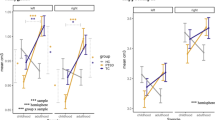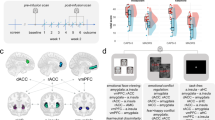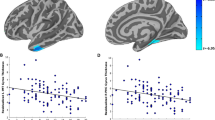Abstract
Posttraumatic stress disorder (PTSD) is considered a disorder of recovery where individuals fail to learn and retain extinction of the traumatic fear response. In maltreated youth, PTSD is common, chronic, and associated with comorbidity. Studies of extinction-related structural volumes (amygdala, hippocampus, anterior cingulate cortex (ACC), and ventral medial prefrontal cortex (vmPFC)) and this stress diathesis, in maltreated youth were not previously investigated. In this cross-sectional study, neuroanatomical volumes associated with extinction in maltreated youth with PTSD (N=31), without PTSD (N=32), and in non-maltreated healthy volunteers (n=57) were examined using magnetic resonance imaging. Groups were sociodemographically similar. Participants underwent extensive assessments for strict inclusion/exclusion criteria and DSM-IV disorders. Maltreated youth with PTSD demonstrated decreased right vmPFC volumes compared with both maltreated youth without PTSD and non-maltreated controls. Maltreated youth without PTSD demonstrated larger left amygdala and right hippocampal volumes compared with maltreated youth with PTSD and non-maltreated control youth. PTSD symptoms inversely correlated with right and left hippocampal and left amygdala volumes. Confirmatory masked voxel base morphometry analyses demonstrated greater medial orbitofrontal cortex gray matter intensity in controls than maltreated youth with PTSD. Volumetric results were not influenced by psychopathology or maltreatment variables. We identified volumetric differences in extinction-related structures between maltreated youth with PTSD from those without PTSD. Alterations of the vmPFC may be one mechanism that mediates the pathway from PTSD to comorbidity. Further longitudinal work is needed to determine neurobiological factors related to chronic and persistent PTSD, and to PTSD resilience despite maltreatment.
Similar content being viewed by others
Log in or create a free account to read this content
Gain free access to this article, as well as selected content from this journal and more on nature.com
or
References
Andreasen NC, Flaum M, Swayze V, O'Leary DS, Alliger R, Cohen G et al (1993). Intelligence and brain structure in normal individuals. Am J Psychiatry 150: 130–134.
Beckmann M, Johansen-Berg H, Rushworth MF (2009). Connectivity-based parcellation of human cingulate cortex and its relation to functional specialization. J Neurosci 29: 1175–1190.
Boes AD, Bechara A, Tranel D, Anderson SW, Richman L, Nopoulos P (2009). Right ventromedial prefrontal cortex: a neuroanatomical correlate of impulse control in boys. Soc Cogn Affect Neurosci 4: 1–9.
Carrion VG, Weems CF, Eliez S, Patwardhan A, Brown W, Ray RD et al (2001). Attenuation of frontal asymmetry in pediatric posttraumatic stress disorder. Biol Psychiatry 50: 943–951.
Carrion VG, Weems CF, Reiss AL (2007). Stress predicts brain changes in children: a pilot longitudinal study on youth stress, posttraumatic stress disorder, and the hippocampus. Pediatrics 119: 509–516.
Carrion VG, Weems CF, Watson C, Eliez S, Menon V, Reiss AL (2009). Converging evidence for abnormalities of the prefrontal cortex and evaluation of midsagittal structures in pediatric posttraumatic stress disorder: an MRI study. Psychiatry Res 172: 226–234.
Cheetham A, Allen NB, Whittle S, Simmons JG, Yucel M, Lubman DI (2012). Orbitofrontal volumes in early adolescence predict initiation of cannabis use: a 4-year longitudinal and prospective study. Biol Psychiatry 71: 684–692.
Cohen RA, Grieve S, Hoth KF, Paul RH, Sweet L, Tate D et al (2006). Early life stress and morphometry of the adult anterior cingulate cortex and caudate nuclei. Biol Psychiatry 59: 975–982.
Dannlowski U, Stuhrmann A, Beutelmann V, Zwanzger P, Lenzen T, Grotegerd D et al (2012). Limbic scars: long‐term consequences of childhood maltreatment revealed by functional and structural magnetic resonance imaging. Biol Psychiatry 71: 286‐293.
De Bellis M, Kuchibhatla M (2006). Cerebellar volumes in pediatric maltreatment-related posttraumatic stress disorder. Biol Psychiatry 60: 697–703.
De Bellis MD, Hall J, Boring AM, Frustaci K, Moritz G (2001). A pilot longitudinal study of hippocampal volumes in pediatric maltreatment-related posttraumatic stress disorder. Biol Psychiatry 50: 305–309.
De Bellis MD, Hooper S, Spratt EG, Woolley DW (2009). Neuropsychological findings in childhood neglect and their relationships to pediatric PTSD. J Int Neuropsychol Soc 15: 868–878.
De Bellis MD, Hooper SR, Chen SD, Provenzale JM, Boyd BD, Glessner CE et al (2015). Posterior structural brain volumes differ in maltreated youth with and without chronic posttraumatic stress disorder. Development and Psychopathology (in press).
De Bellis MD, Keshavan M, Clark DB, Casey BJ, Giedd J, Boring AM et al (1999). A.E. Bennett Research Award. Developmental traumatology. Part II: brain development. Biol Psychiatry 45: 1271–1284.
De Bellis MD, Keshavan M, Shifflett H, Iyengar S, Beers SR, Hall J et al (2002). Brain structures in pediatric maltreatment-related posttraumatic stress disorder: a sociodemographically matched study. Biol Psychiatry 52: 1066–1078.
De Bellis MD, Woolley DP, Hooper SR (2013). Neuropsychological findings in pediatric maltreatment: relationship of PTSD, dissociative symptoms, and abuse/neglect indices to neurocognitive outcomes. Child Maltreat 18: 171–183.
De Bellis MD, Zisk A (2014). . The biological effects of childhood trauma. In: Cozza SJ, Cohen JA, Dougherty JG (eds). Child and Adolescent Psychiatric Clinics of North America: Disaster and Trauma, Vol. 23. Elsevier, pp 185–222.
Desikan RS, Segonne F, Fischl B, Quinn BT, Dickerson BC, Blacker D et al (2006). An automated labeling system for subdividing the human cerebral cortex on MRI scans into gyral based regions of interest. Neuroimage 31: 968–980.
Destrieux C, Fischl B, Dale A, Halgren E (2010). Automatic parcellation of human cortical gyri and sulci using standard anatomical nomenclature. Neuroimage 53: 1–15.
Douaud G, Mackay C, Andersson J, James S, Quested D, Ray MK et al (2009). Schizophrenia delays and alters maturation of the brain in adolescence. Brain 132: 2437–2448.
Famularo R, Fenton T, Augustyn M, Zuckerman B (1996). Persistence of pediatric post traumatic stress disorder after 2 years. Child Abuse Negl 20: 1245–1248.
Famularo R, Fenton T, Kinscherff R (1993). Child maltreatment and the development of post traumatic stress disorder. Am J Dis Child 147: 755–760.
Felitti VJ, Anda RF, Nordenberg D, Williamson DF, Spitz AM, Edwards V et al (1998). Relationship of childhood abuse and household dysfunction to many of the leading causes if death in adults. Am J Prev Med 14: 245–258.
Fischl B, van der Kouwe A, Destrieux C, Halgren E, Segonne F, Salat DH et al (2004). Automatically parcellating the human cerebral cortex. Cereb Cortex 14: 11–22.
Fjell AM, Walhovd KB, Brown TT, Kuperman JM, Chung Y, Hagler DJ Jr et al (2012). Multimodal imaging of the self-regulating developing brain. Proc Natl Acad Sci USA 109: 19620–19625.
Giedd JN, Rapoport JL (2010). Structural MRI of pediatric brain development: what have we learned and where are we going? Neuron 67: 728–734.
Gilbertson MW, Paulus MW, Williston SK, Gurvits TV, Lasko NB, Pitman RK et al (2006). Neurocognitive function in monozygotic twins discordant for combat exposure: relationship to posttraumatic stress disorder. J Abnorm Psychol 115: 484–495.
Hanson JL, Chung MK, Avants BB, Shirtcliff EA, Gee JC, Davidson RJ et al (2010). Early stress is associated with alterations in the orbitofrontal cortex: a tensor based morphometry investigation of brain structure and behavioral risk. J Neurosci 30: 7466–7472.
Hartley CA, Fischl B, Phelps EA (2011). Brain structure correlates of individual differences in the acquisition and inhibition of conditioned fear. Cereb Cortex 21: 1954–1962.
Kaufman J, Birmaher B, Brent D, Rao U, Flynn C, Moreci P et al (1997). Schedule for affective Disorders and Schizophrenia for school-age children-present and lifetime version (K-SADS-PL): initial reliability and validity data. J Am Acad Child Adolesc Psychiatry 36: 980–988.
Kaufman J, Jones B, Stieglitz E, Vitulano L, Mannarino A (1994). The use of multiple informants to assess children's maltreatment experiences. J Fam Violence 9: 227–248.
Keding TJ, Herringa RJ (2014). Abnormal structure of fear circuitry in pediatric post-traumatic stress disorder. Neuropsychopharmacology 40: 537–545 in press.
Kitayama N, Quinn S, Bremner JD (2006). Smaller volume of anterior cingulate cortex in abuse-related posttraumatic stress disorder. J Affect Disord 90: 171–174.
Kuo JR, Kaloupek DG, Woodward SH (2012). Amygdala volume in combat-exposed veterans with and without posttraumatic stress disorder: a cross-sectional study. Arch Gen Psychiatry 69: 1080–1086.
Lange N, Froimowitz MP, Bigler ED, Lainhart JE, and Brain Development Cooperative Group (2010). Associations between IQ, total and regional brain volumes, and demography in a large normative sample of healthy children and adolescents. Dev Neuropsychol 35: 296–317.
Lim L, Radua J, Rubia K (2014). Gray matter abnormalities in childhood maltreatment: a voxel-wise meta-analysis. Am J Psychiatry 171: 854–863.
Lupien SJ, McEwen BS, Gunnar MR, Heim C (2009). Effects of stress throughout the lifespan on the brain, behaviour and cognition. Nat Rev Neurosci 10: 434–445.
Macklin ML, Metzger LJ, Litz BT, McNally RJ, Lasko NB, Orr SP et al (1998). Lower precombat intelligence is a risk factor for posttraumatic stress disorder. J Consult Clin Psychol 66: 323–326.
MacMillan HL, Wathen CN, Barlow J, Fergusson DM, Leventhal JM, Taussig HN (2009). Interventions to prevent child maltreatment and associated impairment. Lancet 373: 250–266.
McLeer SV, Dixon JF, Henry D, Ruggiero K, Escovitz K, Niedda T et al (1998). Psychopathology in non-clinically referred sexually abused children. J Am Acad Child Adoles Psychiatry 37: 1326–1333.
McLeer SV, Ruggiero K (1999). Diagnostic stability following termination of child sexual abuse. Scientific Proceedings of the Annual Meeting of the American Academy of Child & Adolescent Psychiatry XV: 105.
Milad MR, Orr SP, Lasko NB, Chang Y, Rauch SL, Pitman RK (2008). Presence and acquired origin of reduced recall for fear extinction in PTSD: results of a twin study. J Psychiatr Res 42: 515–520.
Milad MR, Pitman RK, Ellis CB, Gold AL, Shin LM, Lasko NB et al (2009). Neurobiological basis of failure to recall extinction memory in posttraumatic stress disorder. Biol Psychiatry 66: 1075–1082.
Milad MR, Quirk GJ (2012). Fear extinction as a model for translational neuroscience: ten years of progress. Annu Rev Psychol 62: 129–151.
Morey RA, Gold AL, LaBar KS, Beall SK, Brown VM, Haswell CC et al Mid-Atlantic MIRECC Workgroup. (2012). Amygdala volume changes with posttraumatic stress disorder in a large case-controlled veteran group. Arch Gen Psychiatry 69: 1169–1178.
Morey RA, Petty CM, Xu Y, Hayes JP, Wagner HR, Lewis DV et al (2009). A comparison of automated segmentation and manual tracing for quantifying hippocampal and amygdala volumes. Neuroimage 45: 855–866.
Neubauer AC, Fink A (2009). Intelligence and neural efficiency. Neurosci Biobehav Rev 33: 1004–1023.
Nichols TE, Holmes AP (2002). Nonparametric permutation tests for functional neuroimaging: a primer with examples. Hum Brain Mapp 15: 1–25.
Østby Y, Tamnes CK, Fjell AM, Westlye LT, Due-Tønnessen P, Walhovd KB (2009). Heterogeneity in subcortical brain development: a structural magnetic resonance imaging study of brain maturation from 8 to 30 years. J Neurosci 29: 11772–11782.
Pechtel P, Lyons-Ruth K, Anderson CM, Teicher MT (2014). Sensitive periods of amygdala development: the role of maltreatment in preadolescence. NeuroImage 97: 236–244.
Perez C, Widom CS (1994). Childhood victimization and long-term intellectual and academic outcomes. Child Abuse Negl 18: 617–633.
Pitman RK, Rasmusson AM, Koenen KC, Shin LM, Orr SP, Gilbertson MW et al (2012). Biological studies of post-traumatic stress disorder. Nat Rev Neurosci 13: 769–787.
Reiss AL, Abrams MT, Singer HS, Ross JL, Denckla MA (1996). Brain development, gender and IQ in children: a volumetric imaging study. Brain 119: 1763–1774.
Richert KA, Carrion VG, Karchemskiy A, Reiss AL (2006). Regional differences of the prefrontal cortex in pediatric PTSD: an MRI study. Depress Anxiety 23: 17–25.
Ridgway GR, Henley SMD, Rohrer JD, Scahill RI, Warren JD, Fox NC (2008). Ten simple rules for reporting voxel-based morphometry studies. NeuroImage 40: 1429–1435.
Roozendaal B, McEwen BS, Chattarji S (2009). Stress, memory and the amygdala. Nat Rev Neurosci 10: 423–433.
Satterthwaite TD, Vandekar S, Wolf DH, Ruparel K, Roalf DR, Jackson C et al (2014). Sex differences in the effect of puberty on hippocampal morphology. J Am Acad Child Adolesc Psychiatry 53: 341–350.
Schiller D, Levy I, Niv Y, LeDoux JE, Phelps EA (2008). From fear to safety and back: reversal of fear in the human brain. J Neurosci 28: 11517–11525.
Schoenbaum G, Shaham Y (2008). The role of orbitofrontal cortex in drug addiction: a review of preclinical studies. Biol Psychiatry 63: 256–262.
Shaffer D, Gould MS, Brasic J, Ambrosini P, Fisher P, Bird H et al (1983). A children's global assessment scale. Arch Gen Psychiatry 40: 1228–1231.
Shaw P, Greenstein D, Lerch J, Clasen L, Lenroot R, Gogtay N et al (2006). Intellectual ability and cortical development in children and adolescents. Nat Lett 440: 676–679.
Smith DK, Johnson AB, Pears KC, Fisher PA, DeGarmo DS (2007). Child maltreatment and foster care: unpacking the effects of prenatal and postnatal parental substance use. Child Maltreat 12: 150.
Smith SM, Jenkinson M, Woolrich MW, Beckmann CF, Behrens TE, Johansen-Berg H et al (2004). Advances in functional and structural MR image analysis and implementation as FSL. Neuroimage 23: S208–S219.
Smith SM, Nichols TE (2009). Threshold-free cluster enhancement: addressing problems of smoothing, threshold dependence and localisation in cluster inference. NeuroImage 44: 83–98.
Spinelli S, Chefer S, Suomi SJ, Higley JD, Barr CS, Stein E (2009). Early-life stress induces long-term morphologic changes in primate brain. Arch Gen Psychiatry 66: 658–665.
Tanabe J, Tregellas JR, Dalwani M, Thompson L, Owens E, Crowley T et al (2009). Medial orbitofrontal cortex gray matter is reduced in abstinent substance-dependent individuals. Biol Psychiatry 65: 160–164.
Teicher MH, Anderson CM, Polcari A (2012). Childhood maltreatment is associated with reduced volume in the hippocampal subfields CA3, dentate gyrus, and subiculum. Proc Natl Acad Sci USA 109: E563–E572.
Thomaes K, Dorrepaal E, Draijer N, de Ruiter MB, van Balkom AJ, Smit JH et al (2010). Reduced anterior cingulate and orbitofrontal volumes in child abuse-related complex PTSD. J Clin Psychiatry 71: 1636–1644.
Tupler LA, De Bellis MD (2005). Segmented hippocampal volume in children and adolescents with posttraumatic stress disorder. Biol Psychiatry 59: 523–529.
van Harmelen A-L, van Tol M-J, van der Wee NJA, Veltman DJ, Aleman A, Spinhoven P et al (2010). Reduced medial prefrontal cortex volume in adults reporting childhood emotional maltreatment. Biol Psychiatry 68: 832–838.
Wagner G, Koch K, Schachtzabel C, Reichenbach JR, Sauer H, Schlösser RGM (2008). Enhanced rostral anterior cingulate cortex activation during cognitive control is related to orbitofrontal volume reduction in unipolar depression. J Psychiatry Neurosci 33: 199–208.
Wechsler D (1991) Wechsler Intelligence Scale for Children. 3rd edn. The Psychological Corporation: San Antonio.
Whittle S, Dennison M, Vijayakumar N, Simmons JG, Yucel M, Lubman DI et al (2013). Childhood maltreatment and psychopathology affect brain development during adolescence. J Am Acad Child Adolesc Psychiatry 52: 940–952.
Woon FL, Hedges DW (2009). Amygdala volume in adults with posttraumatic stress disorder: a meta-analysis. J Neuropsychiatry Clin Neurosci 21: 5–12.
Yehuda R, LeDoux JE (2007). Response variation following trauma: a translational neuroscience approach to understanding PTSD. Neuron 56: 19–32.
Acknowledgements
We would like to thank the staff of the Healthy Childhood Brain Development Research Program, and the individuals who participated in this study. We acknowledge the following support for this research: Supported in parts by K24MH71434 & K24 DA028773 (MDDB), R01 MH63407 (MDDB), R01 AA12479 (MDDB), R01 MH61744 (MDDB) and VHA VISN 6 MIRECC (RAM), VHA CSR&D 5I01CX000120-03 (RAM), VHA CSR&D 5I01CX000748-03(RAM), and NINDS 5R01NS086885-02 (RAM).
Author information
Authors and Affiliations
Corresponding author
Additional information
Supplementary Information accompanies the paper on the Neuropsychopharmacology website
Supplementary information
PowerPoint slides
Rights and permissions
About this article
Cite this article
Morey, R., Haswell, C., Hooper, S. et al. Amygdala, Hippocampus, and Ventral Medial Prefrontal Cortex Volumes Differ in Maltreated Youth with and without Chronic Posttraumatic Stress Disorder. Neuropsychopharmacol 41, 791–801 (2016). https://doi.org/10.1038/npp.2015.205
Received:
Revised:
Accepted:
Published:
Issue date:
DOI: https://doi.org/10.1038/npp.2015.205
This article is cited by
-
Anterior cingulate and medial prefrontal cortex oscillations underlie learning alterations in trait anxiety in humans
Communications Biology (2023)
-
Early life stress predicts trajectories of emotional problems and hippocampal volume in adolescence
European Child & Adolescent Psychiatry (2023)
-
The medial prefrontal cortex and the cardiac baroreflex activity: physiological and pathological implications
Pflügers Archiv - European Journal of Physiology (2023)
-
Glucocorticoid-glucocorticoid receptor-HCN1 channels reduce neuronal excitability in dorsal hippocampal CA1 neurons
Molecular Psychiatry (2022)
-
Prefrontal cortex, amygdala, and threat processing: implications for PTSD
Neuropsychopharmacology (2022)



